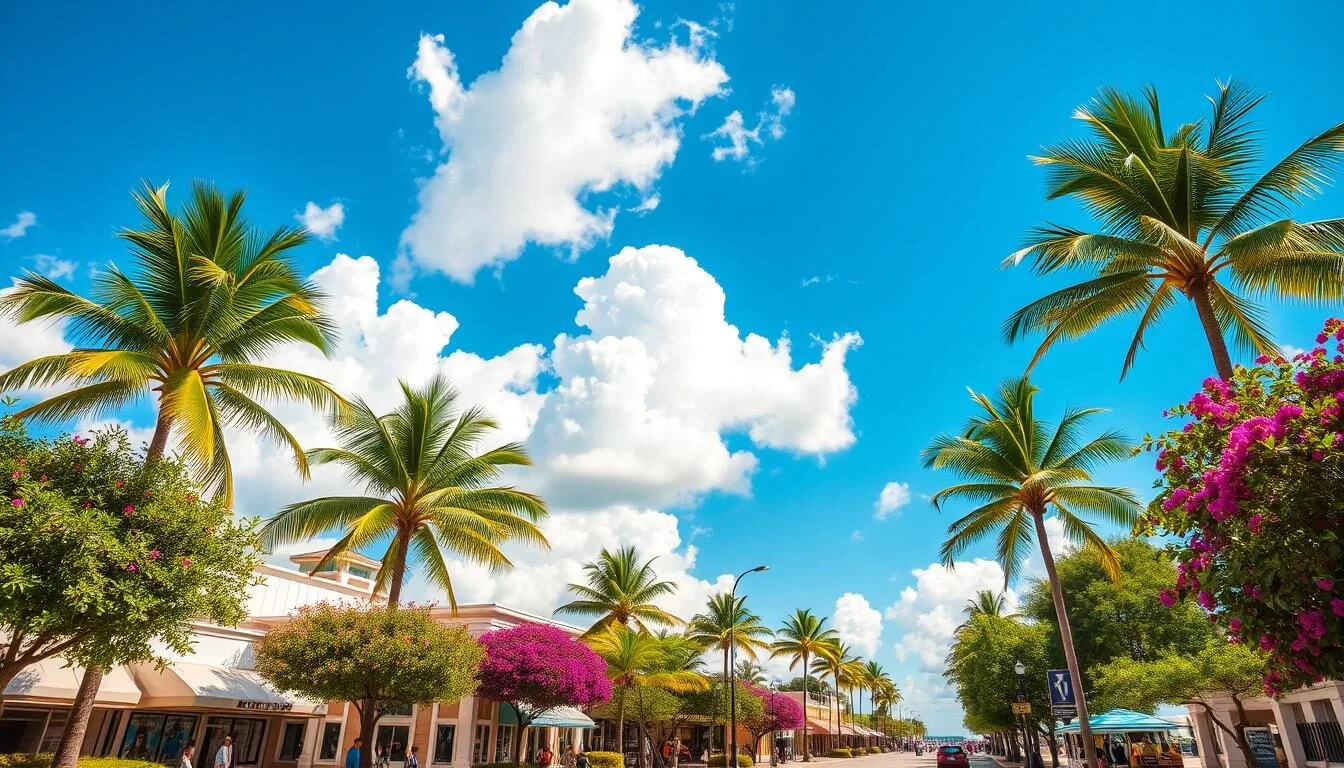✓ Accommodations✓ Flights✓ Rental Cars✓ Tours & Activities
Did you know that nearly 15 million visitors flock to Tampa every year? This vibrant city, situated along Tampa Bay on Florida’s Gulf Coast, is a treasure trove of rich heritage, family-friendly theme parks, and some of the state’s most beautiful beaches.
When planning your trip, timing is everything. Tampa’s subtropical climate means that the weather can significantly impact your vacation experience. Whether you’re looking to soak up the sun on the beach or explore the city’s outdoor attractions, choosing the right time to visit is crucial.
In this guide, we’ll explore Tampa’s seasonal patterns, including temperature fluctuations, rainfall probabilities, and humidity levels. By understanding these factors, you’ll be able to plan a trip that aligns perfectly with your weather preferences and vacation goals.
Understanding Tampa’s Climate Year-Round
Tampa’s climate is characterized by its subtropical weather pattern, making it essential to understand the weather conditions throughout the year. This understanding will help you plan your trip according to your preferences and make the most out of your visit.
Tampa’s Subtropical Weather Pattern
Tampa experiences a subtropical climate, with long, hot, and humid summers and mild, short winters. The temperature varies significantly over the year, typically ranging from 52°F to 90°F. The city’s position on Florida’s Gulf Coast influences its weather, resulting in milder winters and hotter, more humid summers compared to other U.S. destinations.
| Season | Average High Temperature | Characteristics |
|---|---|---|
| Summer | Above 86°F | Long, hot, oppressive, wet, and mostly cloudy |
| Winter | Below 74°F | Short, cool, windy, and partly cloudy |
Key Weather Factors to Consider When Planning
When planning your trip to Tampa, it’s crucial to consider not just the temperature but also precipitation patterns, hurricane season timing, humidity levels, and water temperatures if you plan to engage in beach activities. Tampa’s weather can be divided into distinct wet and dry seasons, with the summer months bringing afternoon thunderstorms and higher humidity that affects outdoor activities.
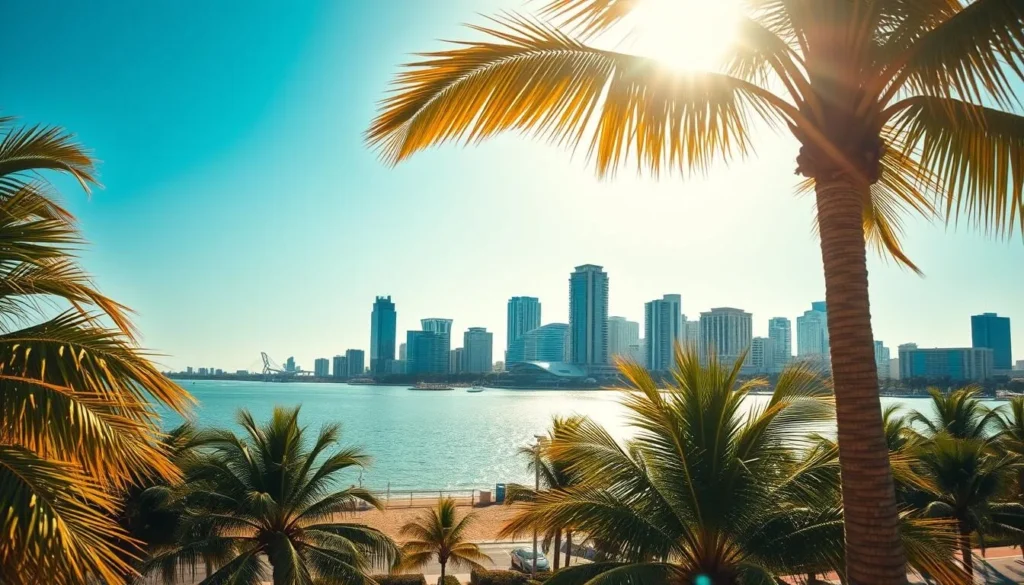
Understanding these climate patterns will help you pack appropriately and schedule activities during the most comfortable times of day for your visit.
The Best Months to Visit Tampa, Florida
For travelers, understanding Tampa’s climate is key to determining the best months to visit. The city’s subtropical weather pattern means that some periods are more favorable than others for a pleasant trip.
October to December: Prime Visiting Season
Visiting Tampa from October to December offers some of the most comfortable weather conditions, with lower humidity and pleasantly warm temperatures. Average daily highs range from 75-84°F, making outdoor activities enjoyable. You’ll also benefit from lower airfares and hotel rates compared to peak summer months.
February to May: Spring Sweet Spot
The February to May window is another excellent time to visit Tampa. Spring brings consistently pleasant temperatures before the summer heat and humidity arrive. Hotel rates and airfares remain relatively affordable during this shoulder season, and you can enjoy numerous local events and festivals.
| Period | Weather | Activities |
|---|---|---|
| October to December | Mild, lower humidity | Outdoor activities, cultural events |
| February to May | Pleasant temperatures | Local festivals, beach activities |
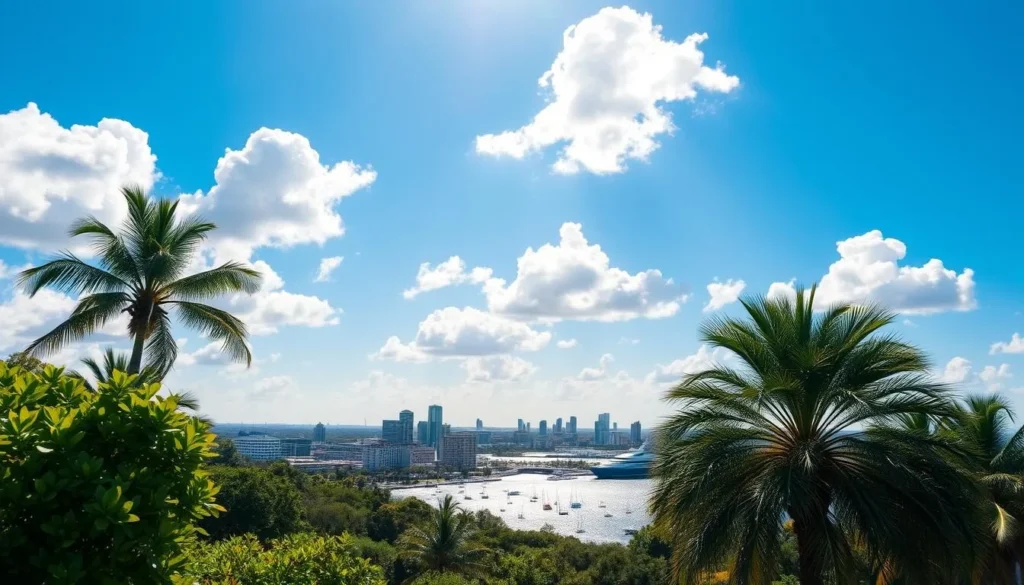
Summer in Tampa: June Through September
Visitors to Tampa during the summer months must be prepared for the heat and humidity that define this time of year. The period from June to September is characterized by high temperatures, frequent thunderstorms, and a significant amount of rainfall.
Heat, Humidity, and Afternoon Thunderstorms
Summer in Tampa brings consistent high temperatures averaging around 90°F, combined with high humidity levels that create a heat index that often feels much hotter. You’ll experience the city’s characteristic afternoon thunderstorms during these months, with brief but intense rainfall typically occurring between 2-6 PM. To make the most of your visit, plan morning activities outdoors and save indoor attractions for the afternoon when storms are most likely.
Navigating Tampa’s Rainy Season
The rainy season in Tampa peaks in August, with the city seeing an average of nearly eight inches of rainfall. Despite the challenging weather, summer offers the warmest water temperatures for swimming, reaching into the mid-80s by August. You’ll find that water parks and beach activities are in full swing during these months, with early morning and evening being the most comfortable times for outdoor recreation. Be prepared for the possibility of hurricanes, although direct hits on Tampa are relatively rare compared to other coastal Florida cities.
- Plan your days around the weather, with outdoor activities in the morning.
- Take advantage of the warm water temperatures for swimming and water sports.
- Consider visiting water parks and enjoying beach activities during the early morning or evening.
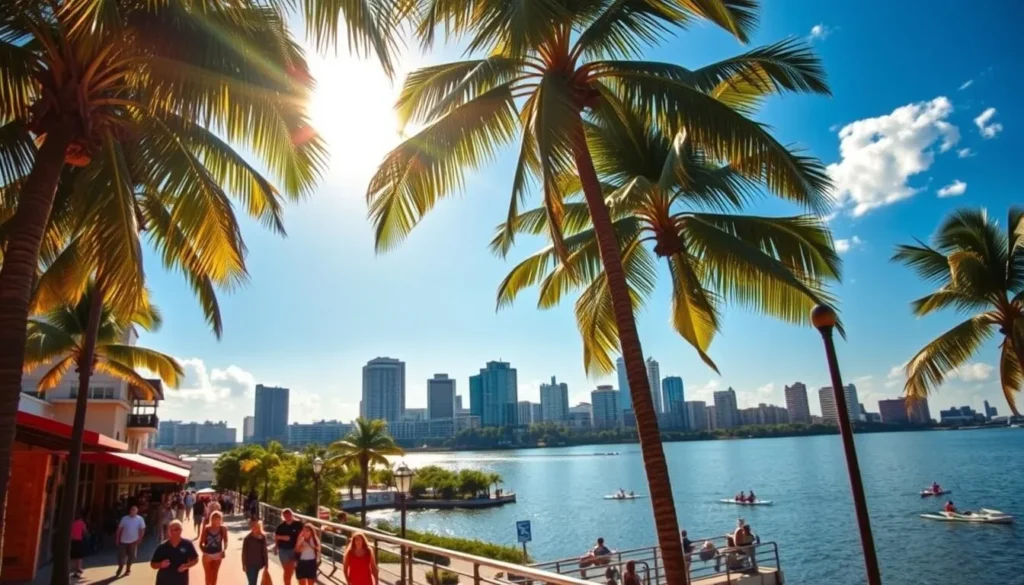
Fall in Tampa: September Through December
The fall season, spanning from September to December, is a great time to visit Tampa, with pleasant weather and exciting events. As the summer heat begins to dissipate, the city experiences a welcome transition in its weather patterns, making it an ideal time for tourists.
Weather Transitions and Comfort Levels
During the fall, Tampa’s weather undergoes a significant transformation. Temperatures and humidity levels gradually decrease as the season progresses from September to December. By October, you’ll notice a substantial drop in rainfall, marking the beginning of Tampa’s dry season. This makes outdoor activities more reliable and enjoyable. By November, average daily temperatures range from 75-80°F, with much lower humidity, creating ideal conditions for exploring Tampa’s outdoor attractions.
Fall Events and Activities
Fall in Tampa is not just about pleasant weather; it’s also a time for exciting events and activities. The season hosts some of Tampa’s most popular events, including Oktoberfest Tampa and Busch Gardens’ Howl-O-Scream. Various food and cultural festivals take place throughout the Tampa Bay area, offering something for everyone. With decreased tourism levels after Labor Day, you can enjoy shorter lines at attractions and more space on Tampa’s beautiful beaches. Additionally, hotel rates and airfares typically drop during the fall months, making it an economical time to visit.

Winter in Tampa: December Through February
You can enjoy Tampa’s mild winters, with average highs in the early 70s, making it perfect for outdoor activities. Winter is a great time to visit Tampa, Florida, as the weather is pleasant, and there are plenty of events to attend.
Mild Temperatures and Lower Humidity
Winter brings Tampa’s most moderate temperatures, with daily highs averaging 70-73°F and evening lows in the comfortable 50-55°F range. You’ll experience the lowest humidity levels of the year during winter months, making outdoor activities particularly pleasant throughout the day. The clear skies and minimal rainfall during this time make it ideal for exploring the city.
- Mild temperatures allow for comfortable outdoor activities like walking, cycling, or visiting local attractions.
- The dry and sunny weather is perfect for water activities like sailing and fishing in Tampa Bay.
Winter Tourism Considerations
Winter is considered high season for northern visitors escaping cold weather, particularly in January and February when “snowbirds” arrive in larger numbers. The season hosts some of Tampa’s most popular events, including the Gasparilla Pirate Festival in January, which has been a local tradition since 1904.
| Month | Average High Temperature | Average Low Temperature | Rainfall |
|---|---|---|---|
| December | 72°F | 54°F | 2.5 inches |
| January | 70°F | 52°F | 2.2 inches |
| February | 73°F | 55°F | 2.8 inches |
![]()
Spring in Tampa: March Through May
Tampa’s spring season is characterized by gradually warming temperatures and a plethora of outdoor activities. This period is ideal for visitors who enjoy mild weather and a range of events.
Pleasant Weather Before Summer Heat
During March, the weather begins to warm up, with average daily highs reaching around 80 degrees Fahrenheit by the end of the month. The dry season continues, making it an excellent time for outdoor activities like boating or attending events like the Gasparilla International Film Festival. As spring progresses, temperatures continue to rise, making the water more inviting for beach activities.
The dry season extends into early May, with minimal rainfall until the wet season begins around mid-May. This allows visitors to enjoy comfortable evenings and warm days without the high humidity that characterizes the summer months.
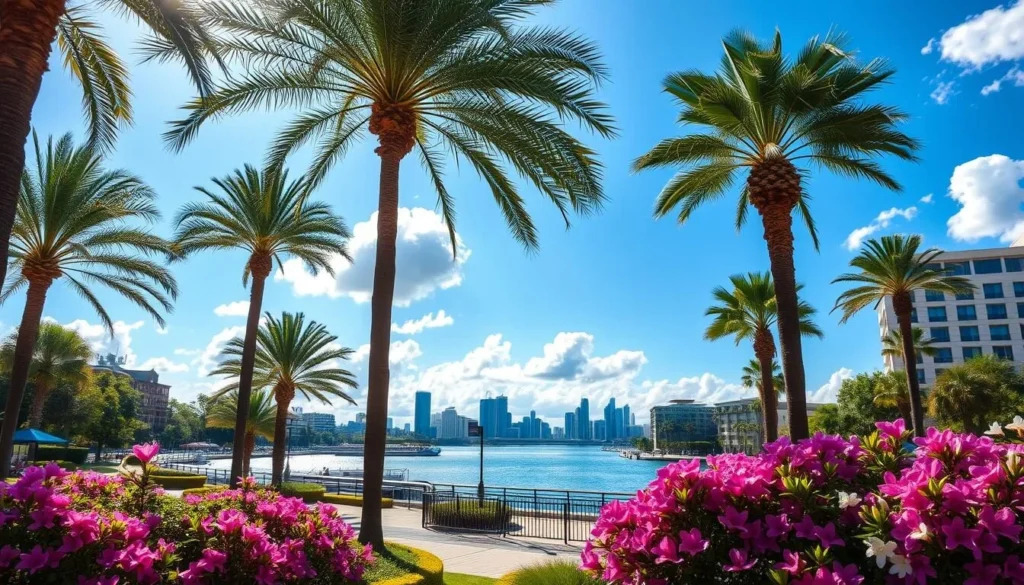
Spring Events and Outdoor Activities
Spring hosts a variety of events and festivals, including the Florida Strawberry Festival in nearby Plant City, Tampa Bay Beer Week, and the Gasparilla International Film Festival. These events offer something for everyone and take advantage of the pleasant weather.
Outdoor enthusiasts can enjoy hiking, boating, and exploring the city’s parks and nature preserves. As water temperatures warm up, reaching the mid-70s by May, beach activities become increasingly appealing.
| Month | Average High Temperature | Events |
|---|---|---|
| March | 77°F | Gasparilla International Film Festival, Tampa Bay Beer Week |
| April | 80°F | Outdoor activities like hiking and boating |
| May | Mid-80s | Florida Strawberry Festival, beach activities |
Hurricane Season Considerations
The Atlantic hurricane season can significantly affect your travel plans to Tampa, so it’s essential to be prepared. Understanding the risks and having a plan in place can make a big difference in your trip.
Understanding the Atlantic Hurricane Season
The Atlantic hurricane season officially runs from June 1 to November 30, with peak activity typically occurring between August and October in the Tampa Bay area. Although Tampa is less vulnerable to direct hurricane hits due to its protected bay location, tropical systems can still impact your travel plans. The chance of a major hurricane directly affecting Tampa during your visit is relatively low, but secondary effects like increased rainfall and wind can occur even from distant storms.

Planning Tips for Visits During Hurricane Season
If you’re planning to visit Tampa during hurricane season, consider purchasing travel insurance that covers weather-related cancellations and disruptions. The Tampa Bay area has excellent emergency management systems in place, with clear evacuation routes and procedures should a major storm threaten during your stay. Many hotels and resorts have hurricane policies that allow for rescheduling or refunds in the event of a named storm affecting the area. Staying flexible with your itinerary during hurricane season allows you to adjust plans if weather forecasts indicate potential storm activity. Despite the hurricane season designation, many visitors enjoy wonderful, storm-free vacations in Tampa during these months.
Best Times for Beach and Water Activities
When planning a trip to Tampa, Florida, understanding the best times for beach and water activities can significantly enhance your experience. The water temperature plays a crucial role in determining the best time for swimming and other water sports.
Water Temperature Variations Throughout the Year
The average water temperature in Tampa Bay experiences significant seasonal variation. The warmest water temperatures occur from June 6 to October 8, with an average temperature above 81°F. August is the month with the warmest water, reaching an average temperature of 85°F. In contrast, the cooler water temperatures last from December 18 to March 25, with an average temperature below 69°F, and February being the coolest month at 65°F.
| Month | Average Water Temperature (°F) |
|---|---|
| June | 82 |
| July | 84 |
| August | 85 |
| September | 84 |
| October | 80 |
| February | 65 |
Optimal Months for Swimming and Water Sports
The optimal months for swimming and water sports in Tampa Bay are from May to October, when the water temperature is consistently above 75°F. During this period, you can enjoy extended swimming sessions and various water activities like jet skiing, paddleboarding, and kayaking. While water sports can be enjoyed year-round, you may prefer a light wetsuit during the winter months.
Visiting Tampa Based on Your Weather Preferences
When planning your trip to Tampa, Florida, your personal weather preferences play a significant role in determining the best time to visit. Tampa offers distinct seasonal experiences, making it crucial to choose a time that aligns with your comfort levels.
For Those Who Prefer Mild Temperatures
If you prefer mild, comfortable temperatures with low humidity, plan your visit between November and April. During this period, daily highs range from 70-80°F, and evenings are pleasantly cool, making it ideal for outdoor activities.
For Those Who Don’t Mind Heat and Humidity
Heat and humidity tolerant travelers can take advantage of lower summer prices and fewer crowds from June through September. Temperatures consistently reach 90°F with high humidity during these months.
For Those Avoiding Rain
Rain-averse visitors should target November through April, with November being statistically the driest month in Tampa, having just 1.5 inches of average rainfall. This period is ideal for those who want to avoid rain and enjoy outdoor activities without interruptions.
Considering your weather preferences is key to a perfect Tampa trip. Whether you prefer mild temperatures, can tolerate heat, or want to avoid rain, there’s a best time for you to visit Tampa.
Conclusion: Planning Your Weather-Perfect Tampa Trip
With a better understanding of Tampa’s weather patterns, you can choose the best time for your visit. The city’s climate varies significantly throughout the year, with fall and winter months being the most popular due to comfortable temperatures and lower humidity.
When planning your trip, consider that October through May offers the most pleasant weather conditions. In contrast, the summer season brings higher temperatures and humidity, but also warmer Gulf waters and potential travel deals. By understanding these patterns, you can tailor your travel dates to your preferences and make the most of your time in Tampa.
—
The above is subject to change.
Check back often to TRAVEL.COM for the latest travel tips and deals.
